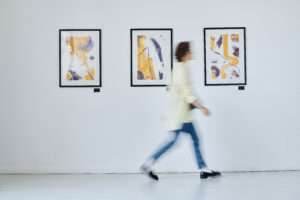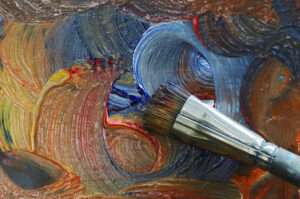The Intersection of Global Art Trade and Forex Markets: An Intriguing Relationship
The global art trade, characterized by its opulence and exclusivity, might not seem directly connected to the intricate world of forex markets. However, beneath the surface, the art trade exerts a significant influence on currency flows and forex dynamics. In this article, we delve into the fascinating relationship between high-value art pieces and the forex market, exploring how auctions, galleries, and art transactions affect currency movements.
The High-Stakes Art Auctions: A Financial Spectacle
Art auctions have long been the epicenter of the global art trade. These events, hosted by renowned houses such as Sotheby’s and Christie’s, showcase rare and valuable artworks that fetch astronomical prices. The dynamics of art auctions play a crucial role in influencing forex markets in several ways.
Auction Results as Economic Indicators
Art galleries are not just venues for displaying art; they are essential players in the art trade ecosystem. Galleries facilitate art transactions, representing artists and connecting buyers with their works. Their activities, both domestic and international, have a direct impact on forex markets.

International Art Exhibitions
Art as a Store of Value: Affecting Currency Flows
Conclusion: Art and Forex – An Unlikely yet Intriguing Partnership
In conclusion, the intersection of the global art trade and forex markets presents an intriguing and often overlooked partnership in the world of finance. The global art trade, characterized by its high-stakes auctions, influential galleries, and unique role as a store of value, wields a significant influence on the dynamics of forex markets.
Art auctions serve as more than just glamorous events; they act as economic indicators, reflecting the confidence and sentiment of investors and collectors in the broader economy. The prices achieved for high-value artworks can signal economic strength or uncertainty, prompting traders in the forex market to take notice and adapt their strategies accordingly.
Galleries play a vital role in connecting artists and buyers on a global scale, facilitating international art transactions that require currency conversions. These transactions, driven by the passion and demand for art, contribute to fluctuations in exchange rates.
Additionally, high-value art’s unique characteristic as a hedge against currency devaluation makes it a sought-after asset during times of economic uncertainty. Investors turn to art as a stable store of value, which leads to increased demand for art pieces and subsequent currency transactions.
As collectors, investors, and art enthusiasts continue to participate in the global art trade, the interplay between the art world and forex markets will remain a fascinating component of the ever-evolving financial landscape. Understanding these intricate dynamics is not only a source of insight but also a valuable tool for investors and traders as they navigate the multifaceted world where art and currency converge.
In essence, the partnership between art and forex markets exemplifies how seemingly unrelated sectors can exert significant influence on each other, underscoring the interconnectedness of the global financial ecosystem.
The global art trade, with its high-stakes auctions, influential galleries, and unique role as a store of value, exerts a fascinating influence on forex markets. Art auctions can serve as economic indicators, while galleries promote international art transactions. High-value art also functions as a hedge against currency devaluation.
As collectors, investors, and art enthusiasts continue to participate in the global art trade, the interplay between the art world and forex markets will persist, providing yet another layer of complexity to the ever-evolving financial landscape. Understanding these dynamics can be valuable for investors and traders alike, as they navigate the intricate world where art and currency converge.
Read our latest article on NGO Activities
FAQs
How does the global art trade influence forex markets?
- The global art trade influences forex markets by generating currency transactions, primarily due to high-value art transactions involving different currencies. These transactions impact exchange rates and currency flows.
2. What role do art auctions play in forex dynamics?
- Art auctions can serve as economic indicators, reflecting confidence or uncertainty in the economy based on the prices achieved for high-value art pieces. These indicators can lead forex traders to adjust their strategies accordingly.
3. How can the anticipation of art auctions affect exchange rates?
- Before major art auctions, increased demand for the currency of the auction location can lead to temporary fluctuations in exchange rates. For instance, buyers may convert their home currencies into the auction currency, affecting its value.
4. What is the significance of international art exhibitions in relation to forex markets?
- International art exhibitions attract global collectors and investors, leading to currency transactions as buyers convert their currencies to make art purchases. This can influence exchange rates, especially when popular artists from one region gain global attention.
5. How does high-value art function as a store of value, and what impact does it have on currency flows?
- High-value art pieces are considered alternative investments and stores of value. During times of economic uncertainty or currency devaluation, investors turn to art, leading to increased demand for art pieces and subsequent currency transactions.
6. What was the impact of the art market during the 2008 financial crisis?
- During the 2008 financial crisis, while traditional investments like stocks and real estate suffered, the art market remained relatively stable. Investors seeking to protect their wealth turned to art, driving up demand and prices.
7. How can art transactions, especially in the high-end segment, act as leading economic indicators?
- Art collectors, often well-informed and connected individuals, may base their buying decisions on their assessment of future economic conditions. Their art investments can provide early signals of economic sentiment, which forex traders may use to anticipate currency movements.
8. Why do forex traders closely monitor the actions of prominent art collectors?
- Prominent art collectors, known for their financial acumen, can provide valuable insights into economic sentiment through their art purchases. Forex traders watch these actions for potential indications of positive or negative economic sentiment and adjust their currency positions accordingly.
9. How can a collector’s decision to invest in art impact forex markets?
- When a prominent collector increases art investments during a period of economic stability, it can be interpreted as a signal of optimism. Forex traders may respond by adjusting their currency positions based on this positive economic sentiment.
10. Why is the connection between the global art trade and forex markets likely to remain of interest in the future?
- As investors and traders continue to seek alternative assets to diversify their portfolios, the art market’s influence on forex dynamics is expected to remain a topic of interest and intrigue. This unique intersection of art and currency will likely continue to unveil new dimensions within the financial world.
Click here to read more on Global Art Trade



